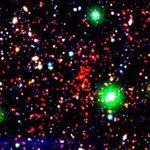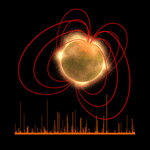Space

Researchers have completed the largest ever survey for very distant clusters of galaxies.
Named the Spitzer Adaptation of the Red-sequence Cluster Survey, "SpARCS" detects galaxy clusters using deep ground-based optical observations from the CTIO 4m and CFHT 3.6m telescopes, combined with Spitzer Space Telescope infrared observations.
SpARCS is designed to find clusters as they appeared lwhen the universe was 6 billion years old or younger. Astronomers believe the universe was formed 13.7 billion years ago.
Clusters of galaxies are rare regions of the universe consisting of…

NASA watch seems to have been first in noticing the way-cool Star-Trek Style NASA poster, cheerfully shown here in all its glory. Yes, this is not your parent's NASA... no, wait, it is. Star Trek also dates from the 60s.
It's a well-done poster, with great poses all around. That's the crew for shuttle Expedition 21. Until we build Star Fleet, I figure these people qualify.
For a full list of NASA mission posters, serious and parody, you can visit http://sfa.nasa.gov/products.cfm.
Alex, not in Star Fleet
The Daytime Astronomer, Tues&Fri here, via RSS feed and…

An enormous plume of water spurts in giant jets from the south pole of Saturn's moon Enceladus and a report published in Nature provides evidence that this magnificent plume is fed by a salty ocean.
The Cassini spacecraft made a surprising discovery about Saturn's sixth largest moon, Enceladus, on its exploration of the giant ringed planet in 2005. Enceladus ejects water vapor, gas and tiny grains of ice into space hundreds of kilometres above the moon's surface.
Enceladus orbits in Saturn's outermost "E" ring. It is one of only three outer solar system bodies that produce active eruptions…

Not all job rejections are equal. Being turned down from the 'Wally the Whale' fish sandwich stop at age 17, for example, was probably a blessing in disguise. Also humorous, as it was my first 'overqualified' experience-- I'd had 2 year's work at a seafood market prior.
That said, some jobs you just want more than others. I'm only a few weeks into my attempt at transitioning to a salaried science writing/web gig. So far the news is mixed. And mixed, as all job-hunters know, means either 'indetermined' or 'bad'.
Having just gotten the 'call of doom' from the first off my "really want" job list…

An enormous eruption has found its way to Earth after travelling for many thousands of years across space. Studying this blast with ESA's XMM-Newton and Integral space observatories, astronomers have discovered a dead star belonging to a rare group: the magnetars.
X-Rays from the giant outburst arrived on Earth on 22 August 2008, and triggered an automatic sensor on the NASA-led, international Swift satellite. Just twelve hours later, XMM-Newton zeroed in and began to collect the radiation, allowing the most detailed spectral study of the decay of a magnetar outburst.
The outburst lasted for…

The interstellar stuff that became incorporated into the planets and life on Earth has younger cosmic roots than theories predict, according to the University of Chicago postdoctoral scholar Philipp Heck and his international team of colleagues.
Heck and his colleagues examined 22 interstellar grains from the Murchison meteorite for their analysis. Dying sun-like stars flung the Murchison grains into space more than 4.5 billion years ago, before the birth of the solar system. Scientists know the grains formed outside the solar system because of their exotic composition.
Philipp Heck with the…

When you go to New York City, to Central Park, to the American Museum of Natural History, to the Hayden Planetarium, to a seminar hosted by Neil deGrasse Tyson, on the entire cosmos, you might think it would be hard to figure out who 'the star' will be.
Well, you're right, but I will tell you before we even get started. The 'star' of the Navigating the Cosmos event at the 2009 World Science Festival, even in such illustrious company as Tyson and the whole Universe, was a guy named Carter Emmart, and I had to look up his actual title ("Director of Astrovisualization for the Rose Center…

Doom and gloom types always want to lament that the presence of people is killing the Earth. Not so, say California Institute of Technology (Caltech) scientists. At least on a cosmic scale, the presence of life may increase longevity for planets.
In traditional thinking, a billion years from now the ever-increasing radiation from the sun will have heated Earth into inhabitability, causing the carbon dioxide in the atmosphere that serves as food for plant to disappear. The oceans will evaporate and all living things will disappear.
Maybe not quite so soon, say researchers…

I've often talked about how amateurs still can make contributions in modern astronomy, making us unique among the sciences. Well, 14-year old Caroline Moore became the youngest person to discover a supernova, through diligence and drive. The story of her find of SN2008ha is both a great character piece, and an example of what a motivated and skilled person can accomplish in 8 months.
Caroline's story hit Slashdot and the Reg, so instead of providing secondhand sources and op eds, I'll push you to the actual details, which are well worth reading. So consider…

Space explorers have found another mystery. The Shrinking Betelgeuse! This red supergiant in the constellation of Orion appears as a bright star to the naked eye observer. It has been found to be shrinking for the last 15 years. By now it has shrunk 15% that is by the size of the Venus orbit!
Generally stars that shrink should become hotter and thus brighter. However no increase in brightness has been seen.
There are speculations, will it implode or explode?? Or maybe we are yet to learn something new in the life of stars.
Source: CNN